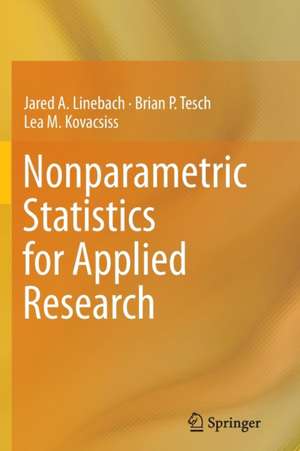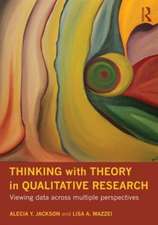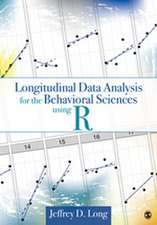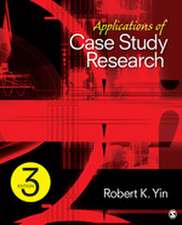Nonparametric Statistics for Applied Research
Autor Jared A. Linebach, Brian P. Tesch, Lea M. Kovacsissen Limba Engleză Paperback – 23 aug 2016
This is a textbook on non-parametric statistics for applied research. The authors propose to use a realistic yet mostly fictional situation and series of dialogues to illustrate in detail the statistical processes required to complete data analysis. This book draws on a readers existing elementary knowledge of statistical analyses to broaden his/her research capabilities. The material within the book is covered in such a way that someone with a very limited knowledge of statistics would be able to read and understand the concepts detailed in the text.
The “real world” scenario to be presented involves a multidisciplinary team of behavioral, medical, crime analysis, and policy analysis professionals work together to answer specific empirical questions regarding real-world applied problems. The reader is introduced to the team and the data set, and through the course of the text follows the team as they progress through the decision making process of narrowing the data and the research questions to answer the applied problem. In this way, abstract statistical concepts are translated into concreteand specific language.
This text uses one data set from which all examples are taken. This is radically different from other statistics books which provide a varied array of examples and data sets. Using only one data set facilitates reader-directed teaching and learning by providing multiple research questions which are integrated rather than using disparate examples and completely unrelated research questions and data.
| Toate formatele și edițiile | Preț | Express |
|---|---|---|
| Paperback (1) | 395.47 lei 6-8 săpt. | |
| Springer – 23 aug 2016 | 395.47 lei 6-8 săpt. | |
| Hardback (1) | 410.66 lei 6-8 săpt. | |
| Springer – 16 noi 2013 | 410.66 lei 6-8 săpt. |
Preț: 395.47 lei
Nou
Puncte Express: 593
Preț estimativ în valută:
75.68€ • 82.18$ • 63.57£
75.68€ • 82.18$ • 63.57£
Carte tipărită la comandă
Livrare economică 23 aprilie-07 mai
Preluare comenzi: 021 569.72.76
Specificații
ISBN-13: 9781493953943
ISBN-10: 149395394X
Pagini: 420
Ilustrații: XII, 408 p. 23 illus., 17 illus. in color.
Dimensiuni: 155 x 235 x 22 mm
Greutate: 0.59 kg
Ediția:Softcover reprint of the original 1st ed. 2014
Editura: Springer
Colecția Springer
Locul publicării:New York, NY, United States
ISBN-10: 149395394X
Pagini: 420
Ilustrații: XII, 408 p. 23 illus., 17 illus. in color.
Dimensiuni: 155 x 235 x 22 mm
Greutate: 0.59 kg
Ediția:Softcover reprint of the original 1st ed. 2014
Editura: Springer
Colecția Springer
Locul publicării:New York, NY, United States
Cuprins
Introduction.- Meeting the Team.- Questions, Assumptions, and Decisions.- Understanding Similarity.- The Bourgeoisie, the Proletariat, and an Unwelcomed Press Conference.- Agreeing to Disagree.- Guesstimating the Fluffy-Maker.- X Marks the Spot Revisited.- Let My People Go!.- Here's Your Sign and the Neighborhood Bowling League.- Geometry on Steroids.- Crunch Time.- Presentation.
Notă biografică
Jared A. Linebach is an Assistant Professor of Forensic Psychology in the Criminal Justice Department at Clearwater Christian College. He earned his Ph.D. from the California School of Forensic Studies. His research and publications involve judicial decision making and campus law enforcement. He is a consultant for doctoral candidates regarding their methodological and statistical approaches to research.
Brian Tesch, MA has spent the past several years using his statistical knowledge to try and help other graduate students to not only learn about statistics, but to make statistics as a whole seem less terrifying. Throughout his academic career, he has focused on researching the impact of domestic violence within the LGBT community, and is now examining the policy and research problems surrounding transgender domestic abuse. He is currently working as a substance abuse counselor for Southeastern New Hampshire Alcohol & Drug Services, and is completing work on a Master of Science degree in the Ethics and Public Policy program at Suffolk University.
Lea M. Kovacsiss currently works as an adjunct instructor, teaching courses in criminal justice and the social sciences. She earned her Ph.D. from the California School of Forensic Studies, and her research interests include child homicide and government response to natural and man-made disasters.
Brian Tesch, MA has spent the past several years using his statistical knowledge to try and help other graduate students to not only learn about statistics, but to make statistics as a whole seem less terrifying. Throughout his academic career, he has focused on researching the impact of domestic violence within the LGBT community, and is now examining the policy and research problems surrounding transgender domestic abuse. He is currently working as a substance abuse counselor for Southeastern New Hampshire Alcohol & Drug Services, and is completing work on a Master of Science degree in the Ethics and Public Policy program at Suffolk University.
Lea M. Kovacsiss currently works as an adjunct instructor, teaching courses in criminal justice and the social sciences. She earned her Ph.D. from the California School of Forensic Studies, and her research interests include child homicide and government response to natural and man-made disasters.
Textul de pe ultima copertă
Non-parametric methods are widely used for studying populations that take on a ranked order (such as movie reviews receiving one to four stars). The use of non-parametric methods may be necessary when data have a ranking but no clear numerical interpretation, such as when assessing preferences. In terms of levels of measurement, non-parametric methods result in "ordinal" data. As non-parametric methods make fewer assumptions, their applicability is much wider than the corresponding parametric methods. In particular, they may be applied in situations where less is known about the application in question. Also, due to the reliance on fewer assumptions, non-parametric methods are more robust. Non-parametric methods have many popular applications, and are widely used in research in the fields of the behavioral sciences and biomedicine.
This is a textbook on non-parametric statistics for applied research. The authors propose to use a realistic yet mostly fictional situation and series of dialogues to illustrate in detail the statistical processes required to complete data analysis. This book draws on a readers existing elementary knowledge of statistical analyses to broaden his/her research capabilities. The material within the book is covered in such a way that someone with a very limited knowledge of statistics would be able to read and understand the concepts detailed in the text.
The “real world” scenario to be presented involves a multidisciplinary team of behavioral, medical, crime analysis, and policy analysis professionals work together to answer specific empirical questions regarding real-world applied problems. The reader is introduced to the team and the data set, and through the course of the text follows the team as they progress through the decision making process of narrowing the data and the research questions to answer the applied problem. In this way, abstract statistical concepts are translated intoconcrete and specific language.
This text uses one data set from which all examples are taken. This is radically different from other statistics books which provide a varied array of examples and data sets. Using only one data set facilitates reader-directed teaching and learning by providing multiple research questions which are integrated rather than using disparate examples and completely unrelated research questions and data.
This is a textbook on non-parametric statistics for applied research. The authors propose to use a realistic yet mostly fictional situation and series of dialogues to illustrate in detail the statistical processes required to complete data analysis. This book draws on a readers existing elementary knowledge of statistical analyses to broaden his/her research capabilities. The material within the book is covered in such a way that someone with a very limited knowledge of statistics would be able to read and understand the concepts detailed in the text.
The “real world” scenario to be presented involves a multidisciplinary team of behavioral, medical, crime analysis, and policy analysis professionals work together to answer specific empirical questions regarding real-world applied problems. The reader is introduced to the team and the data set, and through the course of the text follows the team as they progress through the decision making process of narrowing the data and the research questions to answer the applied problem. In this way, abstract statistical concepts are translated intoconcrete and specific language.
This text uses one data set from which all examples are taken. This is radically different from other statistics books which provide a varied array of examples and data sets. Using only one data set facilitates reader-directed teaching and learning by providing multiple research questions which are integrated rather than using disparate examples and completely unrelated research questions and data.
Caracteristici
Showcases "real-life scenarios" from psychology and medicine Readers learn to analyze data and explain often opaque statistical concepts Each scenario contains real data sets, questions, and self-learning exercises Includes supplementary material: sn.pub/extras












